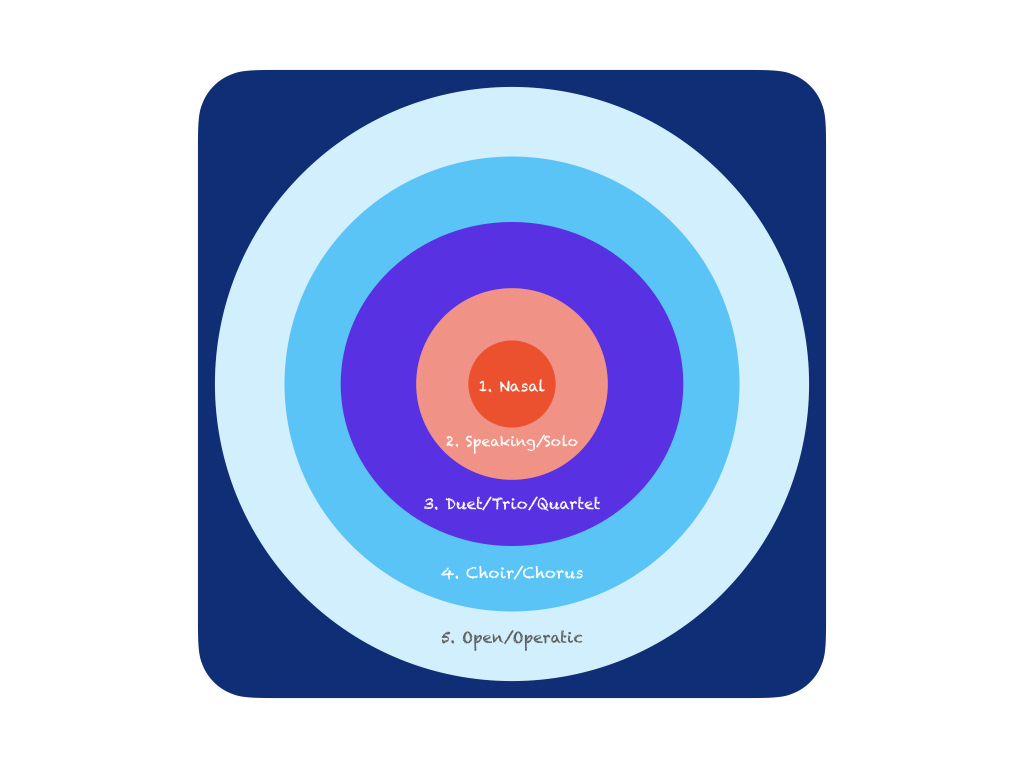By the end of this entry, you will be able to identify five different vocal positions that will help you control your vocal tone for different singing situations.

Glad you asked!
The first vocal position is a very closed shape. This will sound very nasally to yourself, and possibly remind you of a cartoon character . The space in which this sound is created is the most focused area of your singing voice. In order to achieve a balanced onset consistently, this sound needs to be mastered before you can further beautify your sound.
For other examples, think of the way a baby sounds when they cry, the sound of a duck’s “quack”, or the “caw” of a crow. All of these sounds re-created with the human voice will cause the ‘nasal’ vocal shape mentioned above.


The second vocal position is that of your natural speaking voice. This sound is the same quality as when you talk to others at a moderate speaking volume. The space in which this sound is created is spread from the area just above your eyes, down to the mouth. In order to achieve a balanced onset consistently, the comfort of your speaking voice will allow you to feel what a balanced onset should feel like; effortless.
Each word you speak can be translated to a melodic note, no matter how high or low the inflection of your voice. The practice of widening the range of your vocal inflections while speaking will help build your ability to become more accustomed with this vocal position.
The third vocal position is that of when you participate in a duet, trio, or quartet. In either of these situations, it is important that the voices blend harmoniously and without distinction. The only time that a voice part should stand out in this situation is during the appropriate solo sections. This vocal position also creates more space for your voice to resonate through while singing, creating a more present overall vocal sound with added character.
This video shows a great example of a female quartet singing and a capella version of ‘Oh Danny Boy’ with solo sections throughout. As you can hear, the soloist shines through very easily heard, and the background voices support the soloist as a cohesive unit.


The fourth vocal position can be likened to that of the vocal singing in a concert choir. In this situation, each singer in their respective section, must make a constant effort to blend their voices with all of the other sections in the choir. Sopranos need to blend with the altos, the altos with the tenors, and the tenors with the baritones and basses alike.
This is a strong example of a choir that exhibits the vocal blending qualities mentioned above.
The fifth vocal position can be likened to that of an operatic singer. This position can otherwise be known as the widest, most open vocal position. The voice makes a somewhat hollow sound because this vocal position creates a chamber for your voice to resonate through.
Here is an example of an operatic performance in which you may be able to hear the singers’ throats in a wider position than non-operatic singers. This form of singing takes years to master, like all forms of good singing. One thing to note about this type of singing though, is that it should not be done simultaneously with popular forms of singing. Popular forms of singing deal with vocal positions 1 thru 3.


The next lesson will discuss the use of these five vocal positions, and how to apply them to your singing voice properly.
See you soon!
Born and raised in Detroit, Michigan, Ashton Nickolas Moore has expanded his love for music across the ocean to Japan. He began his musical endeavors as a young boy on Detroit’s west side taking lessons in violin, piano, percussion, and voice. He has performed with jazz greats such as
Jon Hendricks, Rodney Whitaker, Wycliffe Gordon, Cyrus Chestnut, Christian McBride and Dianne Reeves. In January of 2005 Ashton performed two concerts of Marvin Gaye’s What’s Goin’On Suite at Dizzy’s Coca Cola Club in Frederick P. Rose Hall in New York, NY.
In October 2008, he was asked by the State of Michigan to perform the national anthem for then Senator, now Past President Barack Obama’s presidential campaign trail in Lansing, MI. From
2008-2021, Ashton lived and worked in the Tokyo area as a professional While humbled
by many experiences overseas such as working and performing for brands such as Honda, Global Dining, as well as high-end fashion brands.
Ashton has gained the experience and confidence to perform as a true world-class musician.
Follow Ashton Moore:
Website: https://ashtonmooremusic.com/
Ashton’s Singing Cafe’: ashtonsingingcafe.com
Facebook: https://www.facebook.com/ashtonsensei
Instagram: https://www.instagram.com/ashtonsensei

